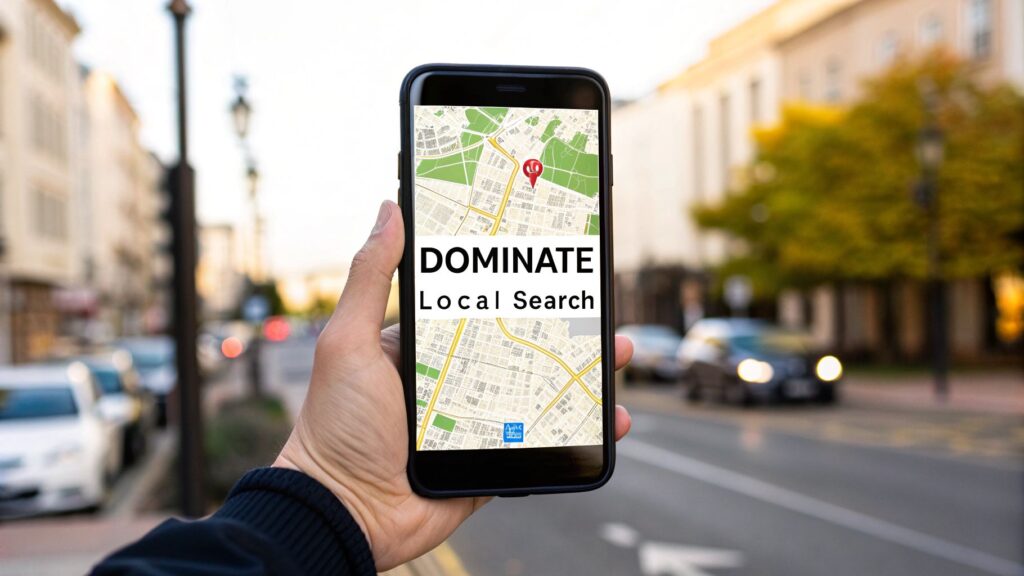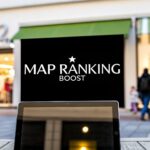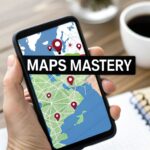You love telling stories and creating beautiful images, not getting a degree in digital marketing. We get it. But what if your ideal clients could find you instead of you constantly chasing them down? That's what SEO for photographers does. It turns your website into a powerful magnet that works for you 24/7.
In Short: SEO helps clients who are already looking for your services find your photography website on Google.
Why SEO Is Your Best Client Magnet
Let’s be honest. You'd rather be behind the camera than trying to figure out social media algorithms or spending money on ads. This is where search engine optimization (SEO) changes the game. It’s not a magic trick; it’s about building a real, sustainable asset for your business.
When a newly engaged couple searches for "downtown Chicago engagement photographer," good SEO is what puts your portfolio at the top of Google's results.

This isn’t just about getting more clicks. It's about getting the right clicks from people actively searching for exactly what you do.
The Core Pillars of Photography SEO
Before we dive deep, it helps to understand what search engine optimization is at its core. For photographers, it comes down to a few key areas that work together to make you more visible online.
Here's a quick breakdown of what to focus on.
Core Pillars of SEO for Photographers
| SEO Pillar | Why It Matters for Photographers | Quick Win |
|---|---|---|
| Keyword Research | This is about understanding what your clients type into Google. Think "mountain elopement photographer near Asheville." | Brainstorm 5 "your service + your city" keyword ideas. |
| On-Page SEO | This tells Google what your pages are about. It involves using keywords naturally on your homepage, galleries, and blog posts. | Update your homepage title to include your main service and location (e.g., "Austin Wedding Photographer |
| Image SEO | Your secret weapon! Naming your image files correctly and adding alt text helps your work show up in Google Image search. | Instead of "IMG_2034.jpg," rename files to be descriptive, like "golden-hour-beach-engagement-photo.jpg." |
| Local SEO | This is critical for getting found by local clients. Optimizing your Google Business Profile is the biggest move you can make. | Fill out your Google Business Profile completely—add services, hours, photos, and get at least 5 client reviews. |
| Technical SEO | This is the "under-the-hood" stuff like site speed and mobile-friendliness. A slow site will send potential clients (and Google) running. | Run your site through Google's PageSpeed Insights to check your mobile score. Image compression is a great first step. |
Getting a handle on these pillars is how you build a reliable system that brings you qualified leads. It turns your website from a simple portfolio into your best marketing employee.
Finding Keywords Your Clients Actually Use
Good SEO for photographers starts with getting inside your ideal client's head. You have to figure out the exact words and phrases they type into Google when they're ready to book. This isn't guesswork; it's about finding the language they use.
Are they searching for a generic "photographer"? Or are they getting specific with something like "candid family photographer" or "moody fine art wedding photographer"? The difference is huge. One is a casual browse, while the other is a targeted search from someone ready to hire.
Thinking Like Your Ideal Client
Grab a pen and paper. Your own experience is a powerful starting point. Brainstorm phrases that describe what you do, who you do it for, and where you're located.
Don't overthink it. Just jot down everything that comes to mind. The goal is to move from broad terms to specific phrases.
- Broad Keyword: "wedding photographer" (very competitive)
- More Specific: "destination wedding photographer" (better)
- Long-Tail Keyword: "mountain elopement photographer near Asheville" (perfect!)
These longer, more descriptive phrases are long-tail keywords. They get fewer searches, but the people who use them know exactly what they want. This means you get inquiries from people who are a perfect fit.
Uncovering Keywords with Free Tools
Once you have a brainstormed list, it's time to validate your ideas. You don't need expensive software.
Google itself is your best friend. Start typing a keyword idea into the search bar and see what Google suggests in the autocomplete dropdown. These are real, popular searches.
The "People Also Ask" section in Google's search results is a goldmine. It's a list of questions your potential clients are asking. Answering these on your site is a great way to show up in search.
Another great free tool is Google Keyword Planner. It’s built for advertisers but gives you solid data on search volume. It will help you figure out which keywords are worth your time.
Here’s a quick look at how keywords plug into your on-page SEO.

As you can see, your keywords influence your page titles, meta descriptions, and image alt text. It all connects.
How do I know which keywords are best for photographers?
The best keywords usually combine your location, your unique style, and your specialty. They should sound natural. For example, "adventurous couples photographer in Moab, Utah" is a great keyword. It targets a specific niche (adventurous couples), a style, and a clear location.
How to Organize Your Photography Keywords
After your research, you'll have a long list of keywords. The final step is to map each keyword (or a small group of related keywords) to a specific page on your website. This gives Google a clear roadmap of your site.
Your keyword map might look like this:
- Homepage: For your main, "big picture" keyword.
- Example: "San Diego Wedding Photographer"
- Service Pages: Each service gets its own targeted keyword.
- Examples: "San Diego Engagement Photography" or "La Jolla Family Portraits"
- Gallery Pages: Use keywords related to the venue or style.
- Example: "Balboa Park Wedding Photos"
- Blog Posts: Use this for long-tail, question-based keywords.
- Example: "What to wear for a beach engagement session in San Diego"
Assigning a primary keyword to each page tells Google, "Hey, this page is the best resource for this specific topic." That clarity helps you rank higher for the searches that turn into paying clients.
Polishing Your Website and Image SEO
Your website is your digital studio. You want it to be clean, easy to navigate, and inviting for both humans and search engines.
This isn't just about a slick design. It’s the behind-the-scenes work that convinces Google to show your site to people and ensures your photos get seen.

What should I put in my SEO title and description?
Think of your title tag and meta description as your digital storefront window on Google. Their job is to get someone to click your link.
-
Title Tag: The big, blue, clickable headline. It needs to be clear, under 60 characters, and include your main keyword. A good formula is:
Primary Keyword | Your Brand Name. For example,San Francisco Wedding Photographer | Jane Smith Photography. -
Meta Description: The small text under the title. It doesn't directly affect rankings but hugely impacts clicks. It’s a mini-ad for your page. For example:
Jane Smith is a San Francisco wedding photographer specializing in authentic, candid moments. See portfolio and pricing for Bay Area weddings and elopements.
In Short: Your title tells Google what the page is about. Your description tells a potential client why they should click.
The Real Secret Weapon: Image SEO for Photographers
Your images are everything. But if they aren't optimized, Google can't "see" them, and you'll miss out on traffic from Google Image search.
Getting your image SEO right is a simple process that pays off big time. It comes down to a few habits you need to build before you upload any photos.
How do I SEO my photos?
It’s all about giving Google context. Search engines are smart, but they can't feel the emotion in a photograph—you have to spell it out for them.
Here’s a simple checklist for every image:
-
Rename Your Image Files: Never upload a file named
IMG_9452.jpg. It tells Google nothing. Rename files with descriptive, keyword-rich phrases separated by hyphens.- Don't:
DSC_0123.jpg - Do:
candid-newborn-lifestyle-photo-austin-tx.jpg
- Don't:
-
Write Descriptive Alt Text: Alt text is a short, written description of an image. It helps visually impaired users and search engines understand your photo. Correctly optimizing image alt attributes is key.
- Weak:
family photo - Strong:
Young family of four laughing together during a golden hour portrait session in a field.
- Weak:
-
Compress Your Images: This is non-negotiable. Large images will slow down your website, which is a major ranking factor.
- Use tools like TinyPNG, or ShortPixel to reduce file sizes without losing quality.
- Try to keep most web images under 200kb. This keeps your pages fast, which makes visitors and Google happy.
Making these three steps part of your workflow creates new ways for clients to find you through Google Image search.
Mastering Local SEO to Dominate Your Market
For most photographers, your next client is probably searching from a coffee shop a few miles away. This is why local SEO is a non-negotiable part of a successful SEO for photographers strategy.
Your biggest ally is your Google Business Profile (GBP). Think of it as your digital storefront on Google Maps and in local search results. It's free and is the most powerful local marketing tool you have.
Getting Your Google Business Profile Just Right
Your GBP is often the first impression a client has of your business. If it’s incomplete, they’ll just scroll to the next photographer. You need to fill out every single section.
Here’s a quick checklist for your profile:
- Pick the Right Categories: Start with "Photographer" as your primary category. Then add specific secondary ones like "Wedding photographer" or "Portrait studio."
- Define Your Service Area: Be specific. If you’re a Boston photographer who also shoots in Cape Cod, list those areas.
- Write a Real Description: Use the 750 characters. Explain what you do, who you serve, and what makes you different. Use keywords naturally, like "Boston family photographer specializing in candid moments."
- List Your Services (in detail!): Don’t just put "Photography." Break it down. Add "Newborn Sessions," "Engagement Shoots," and "Elopement Packages" with descriptions.
In Short: A detailed Google Business Profile gives Google specific information to match with searches, helping you rank for more targeted keywords.
How do I get my photography business to show up on Google Maps?
To get a prime spot on Google Maps, you need a polished Google Business Profile that proves you're a legitimate, active, and trusted local business.
Consistency is key. Your business name, address, and phone number (NAP) must be identical everywhere online—your website, GBP, Yelp, etc.
Also, regularly upload fresh photos from recent shoots and actively ask clients for reviews. These are powerful signals to send to Google.
Building Local Authority and Trust
Your Google profile is just the beginning. You need to weave your local identity into your website. This shows Google you are the expert for your city.
How? Create content that is undeniably local. Write blog posts like "Top 5 Outdoor Locations for Family Photos in Austin" or "A Guide to a Downtown Denver Elopement." These articles attract qualified local traffic and position you as a trusted resource.
A whopping 46% of all Google searches have local intent. Photographers who nail their local strategy can capture a massive share of these clients. Even better, an incredible 88% of local searches on mobile lead to a call or visit within a week. You can find more on this by exploring these SEO insights from Flying V Group.
Getting and Managing Client Reviews
Reviews are social proof that turns a searcher into a client. They're also a massive ranking factor for local SEO. Aim for a steady stream of five-star reviews on your Google profile.
After a session, send your clients a direct link to leave a review on your GBP.
Then, respond to every single one. A thoughtful response shows you care. You can learn more in our guide on how to rank higher on Google fast.
The Technical SEO That Google Loves
"Technical SEO" sounds intimidating. But for photographers, it just means making sure your website is easy for people to use. If your site is slow, visitors will leave, and Google will notice.
A huge part of this is managing your image files. Gorgeous, high-res photos can kill your site's load time. This is where Google's Core Web Vitals come in—they measure that user experience.
Think of it this way:
- Largest Contentful Paint (LCP): How fast does your main image load?
- First Input Delay (FID): When someone clicks your menu, how quickly does it respond?
- Cumulative Layout Shift (CLS): Does your page jump around while loading?
You can get a deeper look at these metrics in this breakdown of Core Web Vitals findings.
Hitting the Right Numbers
Google gives us clear targets. You're in the green zone when your LCP is under 2.5 seconds, your FID is under 100 milliseconds, and your CLS score is below 0.1.
Meeting these goals often comes down to two things: compressing your images and picking a good web host.
Get Your Images Web-Ready
This is non-negotiable. Your portfolio needs to load fast without sacrificing quality.
Before you upload a photo, run it through an optimization tool. I like using TinyPNG or ShortPixel because they're easy. They shrink file sizes with almost no visible loss in quality.
Here are a few habits to get into:
- Resize images first: Don't upload a 5000px wide photo for a space that’s only 800px wide.
- Use lazy loading: This feature only loads images as the visitor scrolls down to them.
- Aim for under 200kb: For gallery thumbnails and blog images, try to keep them under 200kb.
These steps can shave seconds off your load times. A tool like Google's PageSpeed Insights can show you exactly where the bottlenecks are.

As you can see, uncompressed images are almost always the biggest reason for a slow site.
Choose a Host That Can Keep Up
Your web host is the foundation of your site's performance. A cheap, slow host can undo all your hard work. Look for a provider that offers a Content Delivery Network (CDN).
In Short: A fast web host and optimized images are the one-two punch that can boost your rankings and keep potential clients from clicking away.
And don't forget mobile! Most of your clients find you on their phones. Your site needs to work flawlessly on a smaller screen.
A Clean, Logical Site Structure
A confusing website is a dead end for users and search engines. Your site's navigation should be simple. Group your content logically under clear headings like "Portfolio," "Services," "About," and "Blog."
Here are a few best practices:
- Keep your main navigation simple, with 5-7 top-level links at most.
- Use descriptive URLs (e.g.,
yoursite.com/wedding-photography-pricing). - Add breadcrumb links (
Home > Portfolio > Weddings) to show people where they are.
Lock It Down with HTTPS
Having an SSL certificate (which gives you the "https" in your URL) is no longer optional. It builds trust.
Google actively flags sites without HTTPS as "Not Secure." This will scare potential clients away. Many hosts offer a Let's Encrypt certificate for free. Just make sure all your old http:// links redirect to the new, secure https:// version.
Common SEO Questions for Photographers
Let’s dive into some of the most common questions photographers have about SEO. This is about getting you quick, real-world answers.
How long does SEO take for photographers?
SEO is a long game. It's a marathon, not a sprint. While you might see quick wins, like optimizing your Google Business Profile, ranking for competitive keywords takes time.
Think of it like building a reputation. It doesn't happen overnight. Most photographers start seeing meaningful results in about 3 to 6 months of consistent work. This timeline depends on:
- Your Competition: Are you in a small town or a big city like New York?
- Your Website's Age: An older site has a head start over a brand-new one.
- Your Consistency: Blogging regularly and adding new work signals to Google that you're active.
Patience is key. Every blog post you write is another brick in your business foundation.
Do I really need a blog for my photography website?
Yes. Absolutely. Your blog is the most powerful SEO tool you have.
Your main pages can only target a few core keywords. But your blog is a wide-open field. Every post is a new opportunity to show up in Google for what your clients are searching for before they even know they need you.
- "fall engagement photo outfit ideas"
- "best spots for family pictures in Denver"
- "what to expect during a newborn session"
By answering these questions, you become the helpful expert. When it's time to book a photographer, they'll remember you.
How do I balance image quality and website speed?
This is a classic dilemma. The great news is, you don't have to sacrifice one for the other.
In Short: Your incredible photos get you hired, but they have to load for people to see them. The key is smart image optimization.
You can have the best of both worlds. Make image compression a non-negotiable part of your workflow. Before uploading, run photos through a tool like JPEGmini, TinyPNG, or a WordPress plugin like ShortPixel. These tools slash file sizes without a noticeable drop in quality.
Should I put my prices on my website?
From an SEO and client experience perspective, yes. Put yourself in a client's shoes. They're searching for things like "charlotte wedding photographer prices" or "family photo session cost."
If you have a "Pricing" page, you can rank for those searches. Even listing a "starting at" price does two important things:
- It pre-qualifies leads. This saves you time on back-and-forth emails.
- It builds trust. Transparency is everything. It shows you're confident in your value.
For Google, this content adds crucial context, helping you rank for keywords that show someone is ready to book.
At Clicks Geek, we specialize in turning your website into a client-generating machine with powerful local SEO. To see how we can help fill your calendar with ideal clients, explore our SEO services.
Is Your Business Ranking in Google Maps?
Turn Google Maps into a Lead Engine w/ Clicks Geek’s AI-powered local SEO. 3,000+ clients served. Our proprietary, fully done-for-you Maps SEO system handles everything—keyword targeting, local optimization, content, reviews, and ranking strategy—automatically.






